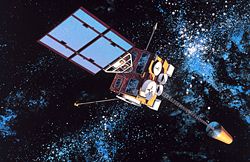 Artist's impression of an SMS-series GOES satellite in orbit | |
| Mission type | Weather satellite |
|---|---|
| Operator | NOAA |
| COSPAR ID | 1978-062A |
| SATCAT no. | 10953 |
| Mission duration | 38 years (achieved) 47 years, 3 months and 24 days (in orbit) |
| Spacecraft properties | |
| Spacecraft type | SMS |
| Manufacturer | Ford Aerospace |
| Launch mass | 627 kilograms (1,382 lb) |
| Start of mission | |
| Launch date | 16 June 1978, 10:49 UTC |
| Rocket | Delta 2914 |
| Launch site | Cape Canaveral LC-17B |
| Contractor | McDonnell Douglas |
| End of mission | |
| Disposal | Decommissioned |
| Deactivated | 29 June 2016 |
| Orbital parameters | |
| Reference system | Geocentric |
| Regime | Geostationary |
| Longitude | 135° West (1978-1981) 90° West (1982-1984) 185° West (1985-1987) 129° West (1987-1990) 175° West (1990-1995) 102-110° West (1996—) [1] [2] |
| Slot | GOES-WEST (1978-1981) |
| Eccentricity | 0.01425 [3] |
| Perigee altitude | 35,469.10 [4] kilometers (22,039.48 mi) |
| Apogee altitude | 36,679.20 [4] kilometers (22,791.40 mi) |
| Inclination | 7.100 [3] degrees |
| Period | 24 hours |
GOES-3, known as GOES-C before becoming operational, was an American geostationary weather and communications satellite. It was originally built for the National Oceanic and Atmospheric Administration as part of the Geostationary Operational Environmental Satellite system, [5] and was launched in June 1978. [6] It was positioned in geostationary orbit, from where it was initially used for weather forecasting in the United States. After ceasing to function as a weather satellite in 1989, it was used as a communications satellite, and spent over thirty-eight years in operation. GOES-3 was decommissioned 29 June 2016 at the Center for Southeastern Tropical Advanced Remote Sensing facility in Miami, Florida. [7]
Contents
GOES-3 was built by Ford Aerospace, and was based on the satellite bus developed for the SMS programme. [8] At launch it had a mass of 627 kilograms (1,382 lb). [2]

